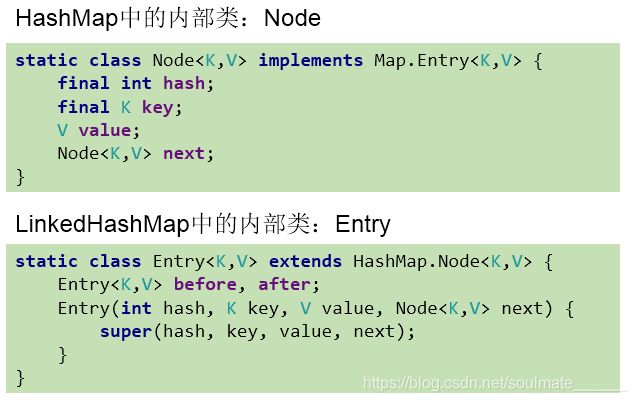Java高级编程:集合
文章目录
- 集合的学习层次
- 集合与数组存储数据概述:
- 数组存储的特点:
- 数组存储的弊端:
- 集合存储的优点:
- Collection接口
- 单列集合框架结构
- Collection接口常用方法:
- Collection集合与数组间的转换
- 使用Collection集合存储对象,要求对象所属的类满足:
- 遍历Collection的两种方式:
- java.utils包下定义的迭代器接口:Iterator
- 作用
- 获取实例
- 图示说明
- remove()的使用:
- 增强for循环:(foreach循环)
- Collection子接口:List接口
- 存储的数据特点:
- 常用方法:
- 常用实现类:
- ArrayList的源码分析:
- LinkedList的源码分析:
- Vector的源码分析:
- 存储的元素的要求:
- Collection子接口:Set接口
- 元素添加过程:(以HashSet为例)
- 常用方法
- 常用实现类:
- 存储对象所在类的要求:
- TreeSet的使用
- 常用的排序方式:
- 双列集合框架:Map
- 常用实现类结构
- 存储结构的理解:
- 常用方法
- 内存结构说明:(难点)
- HashMap在jdk8中相较于jdk7在底层实现方面的不同:
- HashMap底层典型属性的属性的说明:
- LinkedHashMap的底层实现原理
- TreeMap的使用
- 使用Properties读取配置文件
- Collections工具类
- 常用方法
集合的学习层次
-
层次一:选择合适的集合类去实现数据的保存,调用其内部的相关方法。
-
层次二:不同的集合类底层的数据结构为何?如何实现数据的操作的:增删改查等。
集合与数组存储数据概述:
- 集合、数组都是对多个数据进行存储操作的结构,简称Java容器。
说明:此时的存储,主要指的是内存层面的存储,不涉及到持久化的存储(.txt,.jpg,.avi,数据库中)
数组存储的特点:
一旦初始化以后,其长度就确定了。
数组一旦定义好,其元素的类型也就确定了。我们也就只能操作指定类型的数据了。
比如:String[] arr;int[] arr1;Object[] arr2;
数组存储的弊端:
- 一旦初始化以后,其长度就不可修改。
- 数组中提供的方法非常限,对于添加、删除、插入数据等操作,非常不便,同时效率不高。
- 获取数组中实际元素的个数的需求,数组没有现成的属性或方法可用
- 数组存储数据的特点:有序、可重复。对于无序、不可重复的需求,不能满足。
集合存储的优点:
- 解决数组存储数据方面的弊端。
Collection接口
单列集合框架结构
- |----Collection接口:单列集合,用来存储一个一个的对象
-
|----List接口:存储序的、可重复的数据。 -->“动态”数组
-
|----ArrayList、LinkedList、Vector -
|----Set接口:存储无序的、不可重复的数据 -->高中讲的“集合” -
|----HashSet、LinkedHashSet、TreeSet
Collection接口常用方法:
add(Object obj),addAll(Collection coll),size()isEmpty(),clear();contains(Object obj),containsAll(Collection coll),remove(Object obj),removeAll(Collection coll),retainsAll(Collection coll),equals(Object obj);hashCode(),toArray(),iterator();
Collection集合与数组间的转换
//集合 --->数组:toArray()
Object[] arr = coll.toArray();
for(int i = 0;i < arr.length;i++){
System.out.println(arr[i]);
}
//拓展:数组 --->集合:调用Arrays类的静态方法asList(T ... t)
List<String> list = Arrays.asList(new String[]{"AA", "BB", "CC"});
System.out.println(list);
List arr1 = Arrays.asList(new int[]{123, 456});
System.out.println(arr1.size());//1
List arr2 = Arrays.asList(new Integer[]{123, 456});
System.out.println(arr2.size());//2
使用Collection集合存储对象,要求对象所属的类满足:
- 向
Collection接口的实现类的对象中添加数据obj时,要求obj所在类要重写equals().
遍历Collection的两种方式:
- ① 使用迭代器Iterator
- ② foreach循环(或增强for循环)
java.utils包下定义的迭代器接口:Iterator
- Iterator对象称为迭代器(设计模式的一种),主要用于遍历 Collection 集合中的元素。
- GOF给迭代器模式的定义为:提供一种方法访问一个容器(container)对象中各个元素,而又不需暴露该对象的内部细节。迭代器模式,就是为容器而生。
作用
- 遍历集合Collectiton元素
获取实例
- coll.iterator()返回一个迭代器实例
Iterator iterator = coll.iterator();
//hasNext():判断是否还下一个元素
while(iterator.hasNext()){
//next():①指针下移 ②将下移以后集合位置上的元素返回
System.out.println(iterator.next());
}
图示说明
remove()的使用:
测试Iterator中的remove()
- 如果还未调用
next()或在上一次调用next方法之后已经调用了remove方法,再调用remove都会报IllegalStateException。 - 内部定义了
remove(),可以在遍历的时候,删除集合中的元素。此方法不同于集合直接调用remove()
@Test
public void test3(){
Collection coll = new ArrayList();
coll.add(123);
coll.add(456);
coll.add(new Person("Jerry",20));
coll.add(new String("Tom"));
coll.add(false);
//删除集合中"Tom"
Iterator iterator = coll.iterator();
while (iterator.hasNext()){
// iterator.remove();
Object obj = iterator.next();
if("Tom".equals(obj)){
iterator.remove();
// iterator.remove();
}
}
//遍历集合
iterator = coll.iterator();
while (iterator.hasNext()){
System.out.println(iterator.next());
}
}
增强for循环:(foreach循环)
@Test
public void test1(){
Collection coll = new ArrayList();
coll.add(123);
coll.add(456);
coll.add(new Person("Jerry",20));
coll.add(new String("Tom"));
coll.add(false);
//for(集合元素的类型 局部变量 : 集合对象)
for(Object obj : coll){
System.out.println(obj);
}
}
- 内部仍然使用了迭代器
遍历数组举例
遍历数组举例:
@Test
public void test2(){
int[] arr = new int[]{1,2,3,4,5,6};
//for(数组元素的类型 局部变量 : 数组对象)
for(int i : arr){
System.out.println(i);
}
}
Collection子接口:List接口
存储的数据特点:
- 存储序的、可重复的数据。
常用方法:
- 增:add(Object obj)
- 删:remove(int index) / remove(Object obj)
- 改:set(int index, Object ele)
- 查:get(int index)
- 插:add(int index, Object ele)
- 长度:size()
- 遍历:
① Iterator迭代器方式
② 增强for循环
③ 普通的循环
常用实现类:
|----Collection接口:单列集合,用来存储一个一个的对象
- |----List接口:存储序的、可重复的数据。 -->“动态”数组,替换原的数组
-
|----ArrayList:作为List接口的主要实现类;线程不安全的,效率高;底层使用Object[] elementData存储
-
|----LinkedList:对于频繁的插入、删除操作,使用此类效率比ArrayList高;底层使用双向链表存储 -
|----Vector:作为List接口的古老实现类;线程安全的,效率低;底层使用Object[] elementData存储
ArrayList的源码分析:
jdk 7情况下:
ArrayList list = new ArrayList();//底层创建了长度是10的Object[]数组elementDatalist.add(123);//elementData[0] = new Integer(123);- …
list.add(11);//如果此次的添加导致底层elementData数组容量不够,则扩容。- 默认情况下,扩容为原来的容量的1.5倍,同时需要将原有数组中的数据复制到新的数组中。
- 结论:建议开发中使用带参的构造器:ArrayList list = new ArrayList(int capacity)
jdk 8中ArrayList的变化:
ArrayList list = new ArrayList();//底层Object[] elementData初始化为{}.并没创建长度为10的数组list.add(123);//第一次调用add()时,底层才创建了长度10的数组,并将数据123添加到elementData[0]- …
- 后续的添加和扩容操作与jdk 7 无异。
- 小结:jdk7中的ArrayList的对象的创建类似于单例的饿汉式,而jdk8中的ArrayList的对象的创建类似于单例的懒汉式,延迟了数组的创建,节省内存。
LinkedList的源码分析:
LinkedList list = new LinkedList();内部声明了Node类型的first和last属性,默认值为nulllist.add(123);//将123封装到Node中,创建了Node对象。
private static class Node<E> {
E item;
Node<E> next;
Node<E> prev;
Node(Node<E> prev, E element, Node<E> next) {
this.item = element;
this.next = next;
this.prev = prev;
}
}
Vector的源码分析:
- jdk7和jdk8中通过Vector()构造器创建对象时,底层都创建了长度为10的数组。
- 在扩容方面,默认扩容为原来的数组长度的2倍。
存储的元素的要求:
- 添加的对象,所在的类要重写equals()方法
Collection子接口:Set接口
- 存储的数据特点:无序的、不可重复的元素
- 以
HashSet为例说明:
- 无序性:不等于随机性。存储的数据在底层数组中并非照数组索引的顺序添加,而是根据数据的哈希值决定的。
- 不可重复性:保证添加的元素按照
equals()判断时,不能返回true即:相同的元素只能添加一个。
元素添加过程:(以HashSet为例)
- 我们向HashSet中添加元素a,首先调用元素a所在类的hashCode()方法,计算元素a的哈希值,
此哈希值接着通过某种算法计算出在HashSet底层数组中的存放位置(即为:索引位置,判断
数组此位置上是否已经元素:- 如果此位置上没其他元素,则元素a添加成功。 —>情况1
- 如果此位置上其他元素b(或以链表形式存在的多个元素,则比较元素a与元素b的hash值:
- 如果hash值不相同,则元素a添加成功。—>情况2
- 如果hash值相同,进而需要调用元素a所在类的equals()方法:
- equals()返回true,元素a添加失败
- equals()返回false,则元素a添加成功。—>情况2
对于添加成功的情况2和情况3而言:元素a 与已经存在指定索引位置上数据以链表的方式存储。
jdk 7 :元素a放到数组中,指向原来的元素。
jdk 8 :原来的元素在数组中,指向元素a
HashSet底层:数组+链表的结构。(前提:jdk7)
常用方法
- Set接口中没额外定义新的方法,使用的都是Collection中声明过的方法。
常用实现类:
|----Collection接口:单列集合,用来存储一个一个的对象
-
|----Set接口:存储无序的、不可重复的数据 -->高中讲的“集合” -
|----HashSet:作为Set接口的主要实现类;线程不安全的;可以存储null值 -
|----LinkedHashSet:作为HashSet的子类;遍历其内部数据时,可以按照添加的顺序遍历 -
在添加数据的同时,每个数据还维护了两个引用,记录此数据前一个数据和后一个数据。 对于频繁的遍历操作,LinkedHashSet效率高于HashSet. -
|----TreeSet:可以照添加对象的指定属性,进行排序。
存储对象所在类的要求:
HashSet/LinkedHashSet:
- 要求:向Set(主要指:HashSet、LinkedHashSet)中添加的数据,其所在的类一定要重写hashCode()和equals()
- 要求:重写的hashCode()和equals()尽可能保持一致性:相等的对象必须具有相等的散列码
- 重写两个方法的小技巧:对象中用作 equals() 方法比较的 Field,都应该用来计算 hashCode 值。
TreeSet:
- 1.自然排序中,比较两个对象是否相同的标准为:compareTo()返回0.不再是equals().
- 2.定制排序中,比较两个对象是否相同的标准为:compare()返回0.不再是equals().
TreeSet的使用
- 1.向TreeSet中添加的数据,要求是相同类的对象。
- 2.两种排序方式:自然排序(实现Comparable接口 和 定制排序(Comparator)
常用的排序方式:
//方式一:自然排序
@Test
public void test1(){
TreeSet set = new TreeSet();
//失败:不能添加不同类的对象
// set.add(123);
// set.add(456);
// set.add("AA");
// set.add(new User("Tom",12));
//举例一:
// set.add(34);
// set.add(-34);
// set.add(43);
// set.add(11);
// set.add(8);
//举例二:
set.add(new User("Tom",12));
set.add(new User("Jerry",32));
set.add(new User("Jim",2));
set.add(new User("Mike",65));
set.add(new User("Jack",33));
set.add(new User("Jack",56));
Iterator iterator = set.iterator();
while(iterator.hasNext()){
System.out.println(iterator.next());
}
}
//方式二:定制排序
@Test
public void test2(){
Comparator com = new Comparator() {
//照年龄从小到大排列
@Override
public int compare(Object o1, Object o2) {
if(o1 instanceof User && o2 instanceof User){
User u1 = (User)o1;
User u2 = (User)o2;
return Integer.compare(u1.getAge(),u2.getAge());
}else{
throw new RuntimeException("输入的数据类型不匹配");
}
}
};
TreeSet set = new TreeSet(com);
set.add(new User("Tom",12));
set.add(new User("Jerry",32));
set.add(new User("Jim",2));
set.add(new User("Mike",65));
set.add(new User("Mary",33));
set.add(new User("Jack",33));
set.add(new User("Jack",56));
Iterator iterator = set.iterator();
while(iterator.hasNext()){
System.out.println(iterator.next());
}
}
双列集合框架:Map
常用实现类结构
- |----Map:双列数据,存储key-value对的数据 —类似于高中的函数:y = f(x)
- |----HashMap:作为Map的主要实现类;线程不安全的,效率高;存储null的key和value
- |----LinkedHashMap:保证在遍历map元素时,可以照添加的顺序实现遍历。
- 原因:在原的HashMap底层结构基础上,添加了一对指针,指向前一个和后一个元素。
- 对于频繁的遍历操作,此类执行效率高于HashMap。
- |----TreeMap:保证照添加的key-value对进行排序,实现排序遍历。此时考虑key的自然排序或定制排序
- 底层使用红黑树
- |----Hashtable:作为古老的实现类;线程安全的,效率低;不能存储null的key和value
- |----Properties:常用来处理配置文件。key和value都是String类型
- |----HashMap:作为Map的主要实现类;线程不安全的,效率高;存储null的key和value
HashMap的底层:
- 数组+链表 (jdk7及之前)
- 数组+链表+红黑树 (jdk 8)
存储结构的理解:
- Map中的key:无序的、不可重复的,使用Set存储所的key —> key所在的类要重写equals()和hashCode() (以HashMap为例)
- Map中的value:无序的、可重复的,使用Collection存储所的value —>value所在的类要重写equals()
- 一个键值对:key-value构成了一个Entry对象。
- Map中的entry:无序的、不可重复的,使用Set存储所的entry

常用方法
- 添加:put(Object key,Object value)
- 删除:remove(Object key)
- 修改:put(Object key,Object value)
- 查询:get(Object key)
- 长度:size()
- 遍历:keySet() / values() / entrySet()
内存结构说明:(难点)
HashMap在jdk7中实现原理:
HashMap map = new HashMap();
- 在实例化以后,底层创建了长度是16的一维数组Entry[] table。
- …可能已经执行过多次put…
- map.put(key1,value1):
- 首先,调用key1所在类的hashCode()计算key1哈希值,此哈希值经过某种算法计算以后,得到在Entry数组中的存放位置。
- 如果此位置上的数据为空,此时的key1-value1添加成功。 ----情况1
- 如果此位置上的数据不为空,(意味着此位置上存在一个或多个数据(以链表形式存在)),比较key1和已经存在的一个或多个数据的哈希值:
- 如果key1的哈希值与已经存在的数据的哈希值都不相同,此时key1-value1添加成功。----情况2
- 如果key1的哈希值和已经存在的某一个数据(key2-value2)的哈希值相同,继续比较:调用key1所在类的equals(key2)方法,比较:
- 如果equals()返回false:此时key1-value1添加成功。----情况3
- 如果equals()返回true:使用value1替换value2。
- 首先,调用key1所在类的hashCode()计算key1哈希值,此哈希值经过某种算法计算以后,得到在Entry数组中的存放位置。
- 补充:关于情况2和情况3:此时key1-value1和原来的数据以链表的方式存储。
- 在不断的添加过程中,会涉及到扩容问题,当超出临界值(且要存放的位置非空)时,扩容。默认的扩容方式:扩容为原来容量的2倍,并将原的数据复制过来。
HashMap在jdk8中相较于jdk7在底层实现方面的不同:
- new HashMap():底层没创建一个长度为16的数组
- jdk 8底层的数组是:Node[],而非Entry[]
- 首次调用put()方法时,底层创建长度为16的数组
- jdk7底层结构只:数组+链表。jdk8中底层结构:数组+链表+红黑树。
- 4.1 形成链表时,七上八下(jdk7:新的元素指向旧的元素。jdk8:旧的元素指向新的元素)
- 4.2 当数组的某一个索引位置上的元素以链表形式存在的数据个数 > 8 且当前数组的长度 > 64时,此时此索引位置上的所数据改为使用红黑树存储。
HashMap底层典型属性的属性的说明:
DEFAULT_INITIAL_CAPACITY :HashMap的默认容量,16DEFAULT_LOAD_FACTOR:HashMap的默认加载因子:0.75threshold:扩容的临界值,=容量*填充因子:16 * 0.75 => 12TREEIFY_THRESHOLD:Bucket中链表长度大于该默认值,转化为红黑树:8MIN_TREEIFY_CAPACITY:桶中的Node被树化时最小的hash表容量:64
LinkedHashMap的底层实现原理
LinkedHashMap底层使用的结构与HashMap相同,因为LinkedHashMap继承于HashMap.
区别就在于:LinkedHashMap内部提供了Entry,替换HashMap中的Node.
TreeMap的使用
- 向TreeMap中添加key-value,要求key必须是由同一个类创建的对象
- 因为要照key进行排序:自然排序 、定制排序
使用Properties读取配置文件
//Properties:常用来处理配置文件。key和value都是String类型
public static void main(String[] args) {
FileInputStream fis = null;
try {
Properties pros = new Properties();
fis = new FileInputStream("jdbc.properties");
pros.load(fis);//加载流对应的文件
String name = pros.getProperty("name");
String password = pros.getProperty("password");
System.out.println("name = " + name + ", password = " + password);
} catch (IOException e) {
e.printStackTrace();
} finally {
if(fis != null){
try {
fis.close();
} catch (IOException e) {
e.printStackTrace();
}
}
}
Collections工具类
- 作用:操作Collection和Map的工具类
常用方法
reverse(List):反转 List 中元素的顺序shuffle(List):对 List 集合元素进行随机排序sort(List):根据元素的自然顺序对指定 List 集合元素升序排序sort(List,Comparator):根据指定的 Comparator 产生的顺序对 List 集合元素进行排序swap(List,int, int):将指定 list 集合中的 i 处元素和 j 处元素进行交换Object max(Collection):根据元素的自然顺序,返回给定集合中的最大元素Object max(Collection,Comparator):根据 Comparator 指定的顺序,返回给定集合中的最大元素Object min(Collection)Object min(Collection,Comparator)int frequency(Collection,Object):返回指定集合中指定元素的出现次数void copy(List dest,List src):将src中的内容复制到dest中boolean replaceAll(List list,Object oldVal,Object newVal):使用新值替换 List 对象的所旧值

- 说明:ArrayList和HashMap都是线程不安全的,如果程序要求线程安全,我们可以将ArrayList、HashMap转换为线程的。
- 使用synchronizedList(List list) 和 synchronizedMap(Map map)


